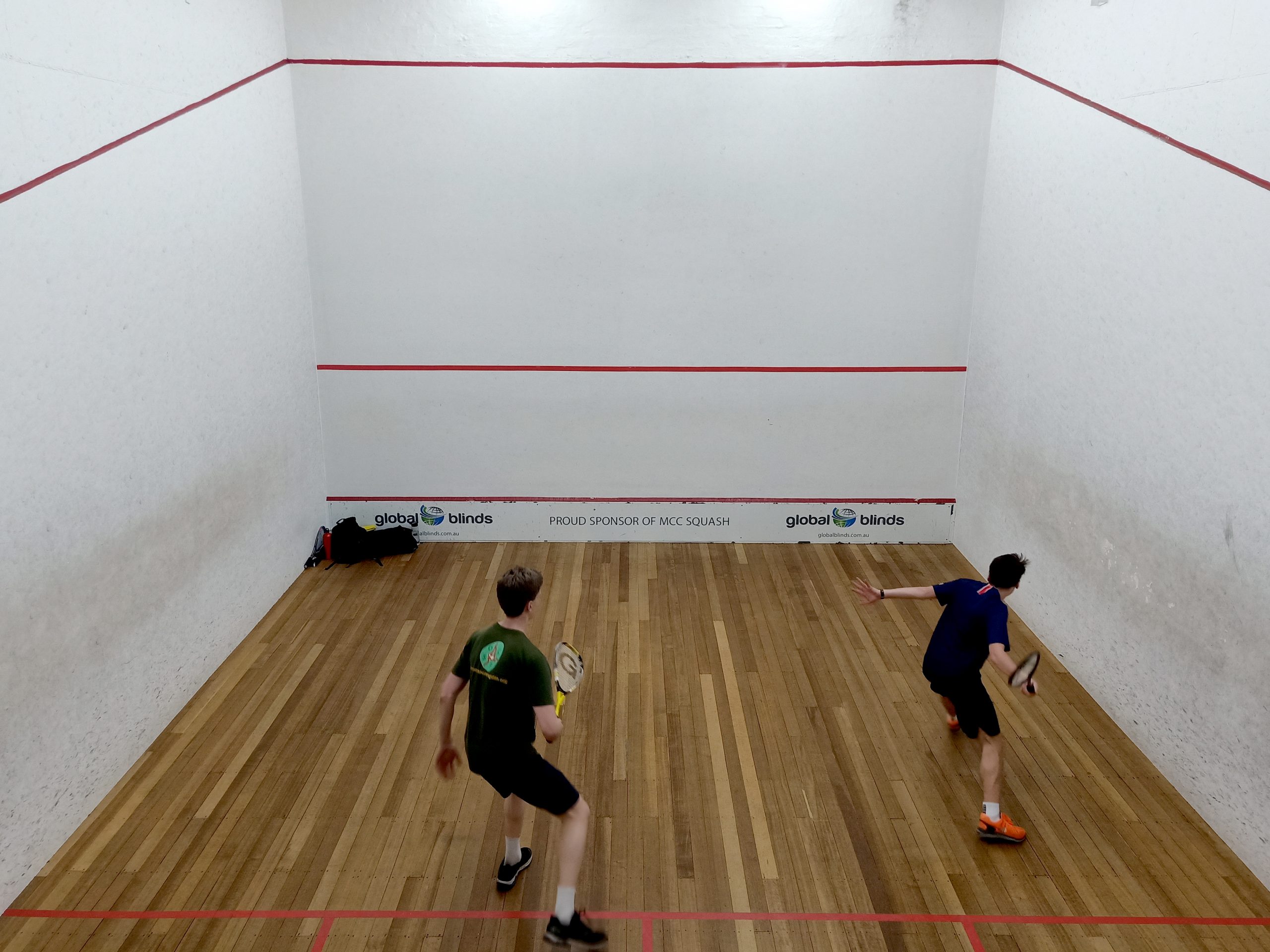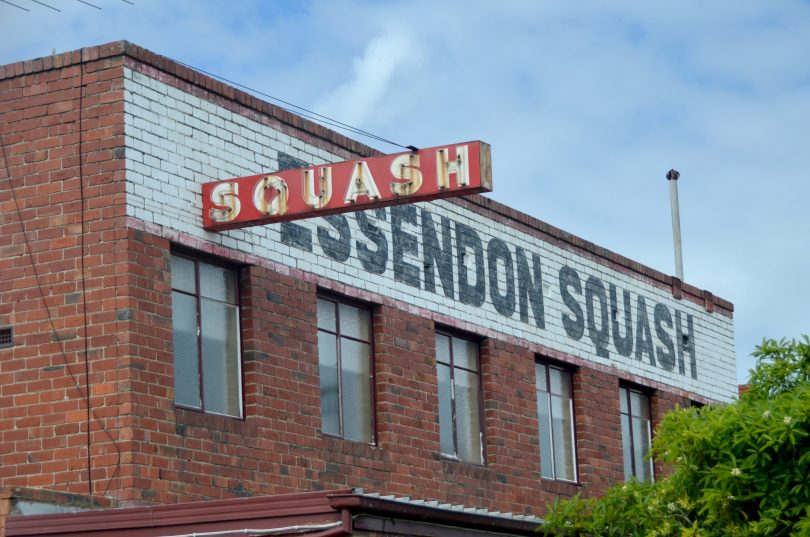The unassuming red brick building is slightly neglected. Its flaking paint and rusty sign give the impression of an establishment well past its prime. Since 1954 the Essendon Squash Centre has been an institution for aspiring Melbourne squash players, yet now it merely offers a glimpse into the past. Only when I approach the building do I detect a sense of life. A pulse. The familiar thunk of a small rubber ball struck hard against a concrete wall. A small yet committed squash community keeps the court’s heart beating. But how did one of our favourite sports slide into relative obscurity?

Essendon Squash Center. Otto McKinnon

A squash game in action at Goodlife Gym Fitzroy. Otto McKinnon
Squash is played on a court approximately 10 meters in length and 6.5 meters across. Two players compete tirelessly, attempting to outplay one another. “It’s just hitting a ball against a wall,” Sue Rainey tells me, “It’s pretty simple really.” Rainey has been running her Essendon Squash Center since 1970, almost fifty years now. At 76 she’s seen a game or two. While the courts have seen better days, Rainey’s squash centre remains as welcoming as ever. From the moment you open the door, you’re sent back in time to the game’s golden era. A time where squash courts were loaded and clubrooms alive with post-game chats and catch-ups.
Rainey believes squash peaked in Australia during the late ’70s or early ’80s. “The courts used to be booked every day until 10 at night,” she said. “At least twenty courts I’d say just in Melbourne.” Not only was the game popular but Australians were good at it, producing world champions such as Heather McKay, Geoff Hunt and Susan Devoy. In the pantheon of Australian sporting legends, Heather McKay might rightly sit alongside Don Bradman or Phar Lap.
One of the greatest squash players in the history of the game, McKay played competitively from 1960-1981, losing only two matches throughout that entire period and winning 16 consecutive British Open titles between 1962 and 1977. The Sydney Morning Herald once dubbed her ‘Australia’s greatest ever sportswoman’. “I never received much attention at all,” McKay told me. “I’ve had some official recognition. I’m now a legend in the Sport Australia Hall of Fame, but back in the ’60s squash was considered a minor sport in the eyes of the media.” Although squash had huge numbers playing, it really didn’t get much publicity, she said.
McKay believes the lack of media attention was a major factor in the decline of the sport. “I’ve always said, for a sport to be successful it has to be televised.” She has a point. Squash doesn’t lend itself to being a spectator sport, and broadcast games made for difficult viewing in the ’60s and ’70s. “That was always the problem. You couldn’t charge people to come and watch,’ Rainey told me.
I asked McKay why the sport has seen a steady decline in Australia while in places such as Egypt it’s booming. Egyptian players currently feature six times in the top 10 men’s world rankings and four times in the female rankings. “I think we’ve got too many sports here,” she said.
Despite Australia’s illustrious past, squash has not produced an Australian world champion in over ten years. Rachael Grinham was the last Australian to win a major title back in 2007, and currently no Aussie rates in the top 10 World Squash Rankings. “When you have champions it certainly helps the sport and increases participation,” says Leigh Evans, director at Squash and Racquetball Victoria (S+R Vic).

Sue Rainey at the Essendon Squash Court reception desk, 2019. Otto McKinnon

A detail shot of the Essendon Squash Centre. Otto McKinnon
By the late ’80s and early ’90s, it seemed that squash’s glory days had come and gone. “Indoor tennis came in, indoor cricket and soccer came along,” said Rainey. “Gyms and aerobics all became the new thing.” Since the early ’90s, the decline has been gradual but severe, with research institute Roy Morgan citing a 67 percent decrease in player numbers between 2001 and 2016. In a list of 27 different sports, the decline of squash is only exceeded, narrowly, by billiards. Squash now sits in 24th place on the list of Australia’s most played competitive sports. That’s behind baseball and barely above ballroom dancing.
“Australians are losing their competitive spirit when it comes to playing sport,” said Michele Levine, CEO of Roy Morgan. “Instead, more of us routinely go cycling or jogging, hiking and bushwalking, or head to the gym or yoga class.” This is the last thing squash court operators want to hear. According to The Courier-Mail, in 1982 Brisbane had 90 squash venues across the city with 5,000 registered competing players. By 2018 that number had dropped to 1,000 players across a mere 20 venues.
Despite its decline, the sport continues to offer unique attractions. I spoke to players at Goodlife Gym in Fitzroy, a facility previously known as Hunt’s Squash. “It’s tennis for angry people”, a player told me, panting from a recent game. I’m not sure how accurate this description really might be, but squash is certainly a good way to let off steam. In 2003, Forbes Magazine ranked squash ‘The Healthiest Sport in the World’. It encourages quick bursts of speed as well as lunges and quick manoeuvring, rewarding high cardiovascular endurance and muscle strength. Players dart across wooden floorboards, dancing around one another.
Benjamin Peach, a 20-year-old Melbournian has been playing socially for the past seven years. Like many other young players, he got into the game after his parents encouraged him to give it a go. “Mum used to play when she was at university, back in the mid-’80s. It was really popular back then,” Peach says. “You don’t see a lot of people playing nowadays.”
Operating a squash centre in an area like inner-city Melbourne is simply no longer financially viable. Squash centres occupy large pieces of expensive real estate. They require high maintenance for low financial returns. The average price for one-hour squash court hire is $30. In that same space, a gym might accommodate 15 people doing an aerobics class. Charge them $15 each and that’s a $225 return compared to the $30 generated by a squash court. It’s little wonder then that Sue Rainey’s Essendon Squash Center is the last of its kind still in operation. “It’s a very sad thing for the sport, so part of me staying around is simply giving my players somewhere to play,” she said.
Rainey believes that the current lack of courts will dramatically limit future growth in the sport. “I think squash will always survive but it won’t get back to what it was because there are now so few courts. Just in this area, there were 4 or 5 centres; nowadays only two of those remain and they’ve been bought by gyms,” she said. Since the late ’80s, Rainey has watched her competitors slowly evaporate as they sell their properties to developers or large gym chains. Squash courts take up large areas of inner-city land that is now worth a small fortune.
It is understandable that operators have sold their courts for a large paycheck, yet Rainey refuses to do the same. “The gyms change it all, the people that work there are just there to take your money.” Leigh Evans from S+R Vic believes gyms care little about increasing squash participation. “They might give you the wrong instruction, wrong racquet, they have no idea about the different balls which can impact how enjoyable the sport is.”
McKay and Rainey both spoke to me about the value and the demise of the tight-knit squash community. “From what I’ve seen the community is not what it used to be. We used to all come together, we’d all be there at, say, eight o’clock,” McKay said. “All the matches would be played and we’d all have supper and get home at two o’clock in the morning.” Rainey and the Essendon Squash Court are determined to make sure these traditions don’t die out.

The Essendon Squash Centre’s clubhouse. Otto McKinnon







